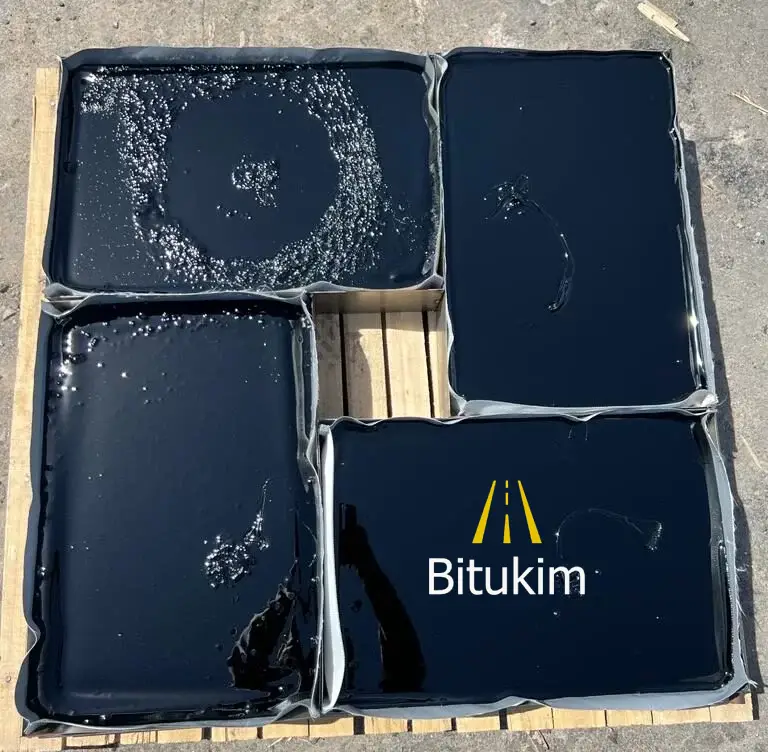
General Description
Blown Bitumen, Air-Rectified Bitumen, or Hard Asphalt, is the name of Oxidized Bitumen 90/15, a semi-solid grade bitumen that results from air-blowing penetration-grade bitumen (typically 60/70) at high temperatures. By the process of controlled oxidation, it raises the softening point of the bitumen while it reduces its penetration, thus making it harder and rubbery but chemically stable and also water-resistant.
It is heavily used in applications where resistance to strong adhesion, low-temperature susceptibility, and thermal deformation is required.
Technical Properties of Oxidized Bitumen 90/15
“90/15” refers to the softening point of the bitumen (90°C) and the penetration value (15 dmm). The higher softening point ensures high-temperature stability, and low penetration value indicates high hardness and resistance to flow.
Test Values:
Softening Point (ASTM D36): 85–95 °C
Penetration (ASTM D5 @ 25°C): 10–20 dmm
Specific Gravity (ASTM D70): ~1.05
Ductility (ASTM D113): ≥1.5 cm
Loss on Heating (ASTM D6): ≤0.2%
Flash Point (ASTM D92): ≥250 °C
Solubility in CS2 (ASTM D4): ≥99.5%
Spot Test (AASHO T102): Negative
Key Applications
Oxidized Bitumen 90/15 is widely used in various industries due to its specific properties such as high softening point, flexibility, and resistance to water and chemicals. It is one of the major components in roofing and waterproofing industries, particularly in manufacturing roofing felts, sound-absorbing sheets, and pipeline protective coatings. In automotive industries, it is used as a base for undercoating materials with superior waterproofing, noise absorption, and dust protection.
In construction work, it is commonly used for sealing joint and saw cuts where there will be limited movement. It is also used as a binding agent for parquet floorings, insulation systems, and for filling hidden cracks.
Oxidized Bitumen 90/15 is also used to manufacture bituminous mastics for oil and gas pipeline and manufacture adhesives in electrical laminates, corrosion-resistant coatings for metals, and as a base for artificial grass. Its chemical stability and hardness make it suitable for thermal insulation, dusting, and even the production of rubber and plastic-based products.
Advantages
- Excellent permanent adhesion
- High water, acid, and alkali resistance
- Chemically and thermally stable
- Impact-resistant and flexible
- High soil and temperature stress durability
- Electrically insulating
Handling and Storage
Safe storage and handling of Oxidized Bitumen 90/15 are necessary for product performance and safety. The material must first be broken down into smaller pieces to optimize surface area to allow for even heating, reduce the possibility of localized overheating, and avoid thermal cracking, which may release low flash point vapors, contributing to fire hazards.
During heating, temperature plays an important role. Bitumen is required to be heated to approximately twice its softening point in order to achieve an acceptable viscosity for utilization. It should not be heated excessively to minimize product integrity and minimize health risks. Storage facilities should be ignition-free, dry, and ventilated, as the fumes formed during heating can be hazardous when inhaled.
The workers handling oxidized bitumen must wear protective equipment, including heat-resistant gloves, protective footwear, goggles, and long-sleeved clothing. Proper ventilation and the presence of fire extinguishing appliances are required to prevent accidents.
Health & Safety Rules
Ventilation: Ensure good air flow while heating to vent the fumes.
PPE: Use safety goggles, heat-resistant gloves, long-sleeved clothing, and protective footwear.
Fire Safety: Avoid open flames and ensure extinguishing devices are within easy access.
Packing Options
Oxidized Bitumen 90/15 is packed in:
20 kg and 50 kg Kraft Paper Bags
25 kg Carton Boxes
Steel Drums (150, 180, 200 kg)
Molded Polyamide Bags (for convenience of application and faster cooling)
Kraft paper bags are recyclable and can be shipped palletized or loose. Molded forms are slightly more expensive but highly convenient for high-speed applications.
Why Choose BituKim?
BituKim is a trusted supplier and exporter of oxidized bitumen products globally. Our experienced staff ensure consistent product quality, punctual delivery, and full technical support. We are committed to learning your unique application needs and providing customized solutions.
Specification of Oxidized Asphalt 90/15
| Bitumen 90/10 | Test method | Unit | Specification |
|---|---|---|---|
| Specific gravity @25/25 C | ASTM D70 | (Kg/m3) | 1.05 approx. |
| Penetration @ 25°c | ASTM D5 | mm/10 | 5/15 |
| Softening point °c | ASTM D36 | °C | 85/95 |
| Ductility @25 °c | ASTM D113 | Cm | 1.5min |
| Loss on heating(wt) % | ASTM D6 | Wt. % | 0.2 max |
| Flashpoint c | ASTM D92 | °C | 250 min |
| Solubility is CS2(wt) % | ASTM D4 | Wt. % | 99.5 max |
| Spot test | A.A.S.H.O.T102 | — | Negative |

